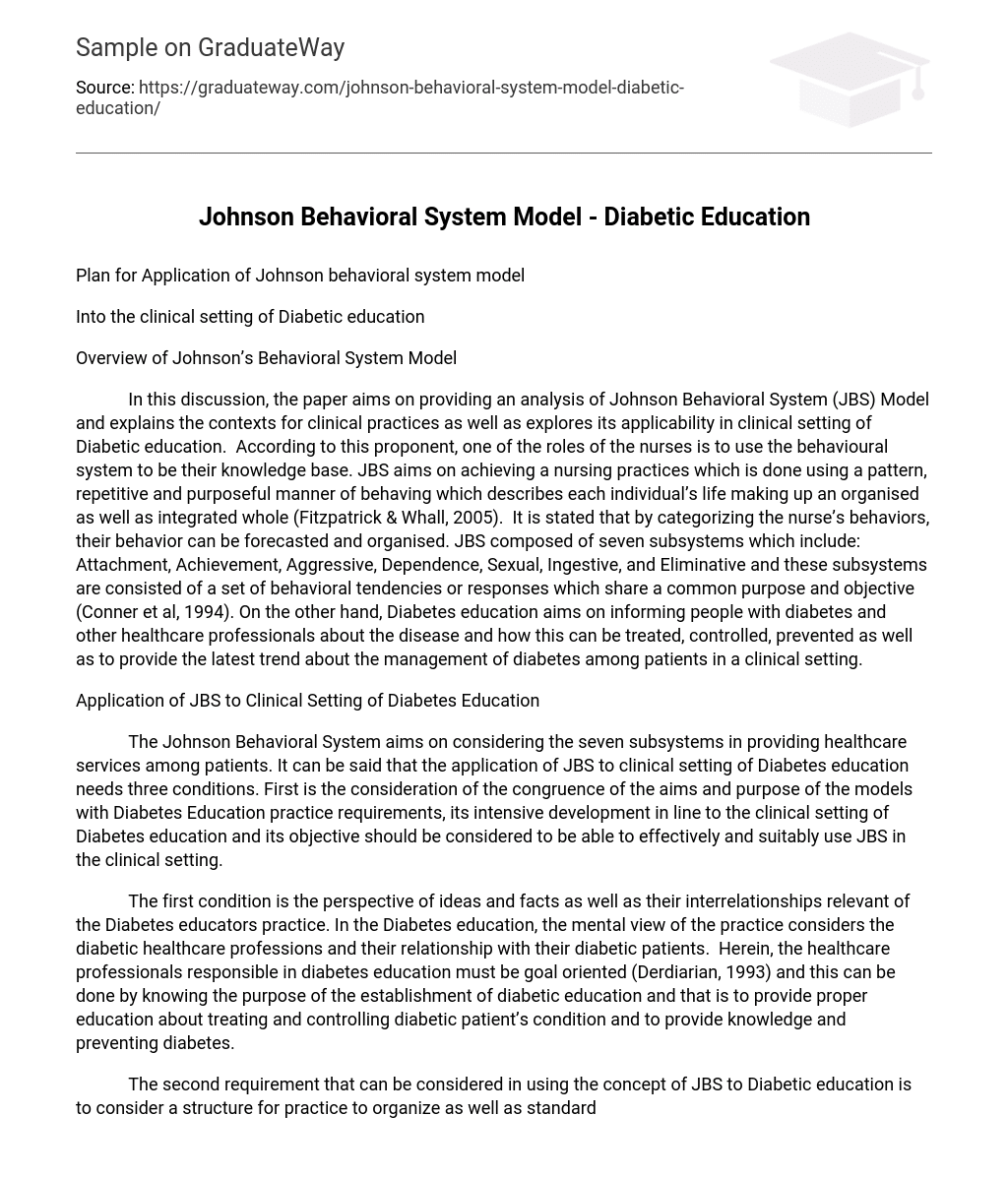In this discussion, the paper aims on providing an analysis of Johnson Behavioral System (JBS) Model and explains the contexts for clinical practices as well as explores its applicability in clinical setting of Diabetic education. According to this proponent, one of the roles of the nurses is to use the behavioural system to be their knowledge base. JBS aims on achieving a nursing practices which is done using a pattern, repetitive and purposeful manner of behaving which describes each individual’s life making up an organised as well as integrated whole (Fitzpatrick & Whall, 2005). It is stated that by categorizing the nurse’s behaviors, their behavior can be forecasted and organised. JBS composed of seven subsystems which include: Attachment, Achievement, Aggressive, Dependence, Sexual, Ingestive, and Eliminative and these subsystems are consisted of a set of behavioral tendencies or responses which share a common purpose and objective (Conner et al, 1994). On the other hand, Diabetes education aims on informing people with diabetes and other healthcare professionals about the disease and how this can be treated, controlled, prevented as well as to provide the latest trend about the management of diabetes among patients in a clinical setting.
The Johnson Behavioral System aims on considering the seven subsystems in providing healthcare services among patients. It can be said that the application of JBS to clinical setting of Diabetes education needs three conditions. First is the consideration of the congruence of the aims and purpose of the models with Diabetes Education practice requirements, its intensive development in line to the clinical setting of Diabetes education and its objective should be considered to be able to effectively and suitably use JBS in the clinical setting.
The first condition is the perspective of ideas and facts as well as their interrelationships relevant of the Diabetes educators practice. In the Diabetes education, the mental view of the practice considers the diabetic healthcare professions and their relationship with their diabetic patients. Herein, the healthcare professionals responsible in diabetes education must be goal oriented (Derdiarian, 1993) and this can be done by knowing the purpose of the establishment of diabetic education and that is to provide proper education about treating and controlling diabetic patient’s condition and to provide knowledge and preventing diabetes.
The second requirement that can be considered in using the concept of JBS to Diabetic education is to consider a structure for practice to organize as well as standardized practice to be able to ensure that the diabetic healthcare providers render their practice in a customary and habitual (repetitive) behavior. In this regard, those involved in diabetic education is structured to assess the patient’s well being, identify their problems in line with diabetes and provide immediate solutions. The last condition is to apply the context of JBS with clinical setting of diabetic education is the consideration of the coherence of the scientific body of knowledge which motivates it or the action of the healthcare professionals involved in the diabetic education’s process and actions. This knowledge is composed of theories, facts, precepts, hypothesis and assumptions underlying both the structure and perspective of the practice. It can be said that Johnson behavior system meets the needs of the diabetic education perspective requirements due to the interaction between the seven subsystems.
Hence, to be able to consider JBS model in the diabetic education clinical practice, healthcare professionals should consider the three requirements for effective and successful integration of both the model and the clinical setting.
Reference
Conner, S. S., Harbour, L. S., Magers, J. A., and Watt, J. K. (1994). Dorothy E. Johnson: Behavioral System Model. In Ann Marriner-Tomey (3rd ed.), Nursing Theorists and Their Work (pp. 231-240). St. Louis: Mosby-Year Book, Inc.
Derdiarian, A. K. (1993). An instrument for research and theory development using the Behavioral System Model for Nursing: The cancer patient. Part I. Nursing Research, 32:4, 196-201.
Fitzpatrick, J., & Whall, A., (2005). Conceptual models of nursing: analysis and application. Saddle River, New Jersey: Pearson Education.





